Emisar D4v2 flashlight review: EDC
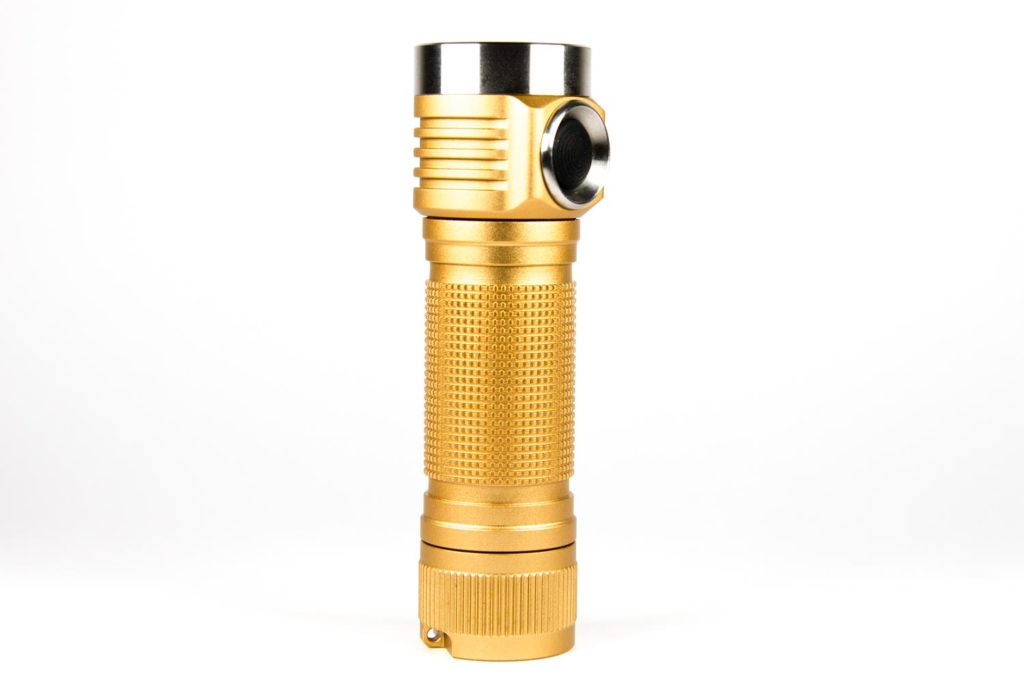
Introduction:
The Emisar D4V2. A light that, by now, needs little to no introduction to anyone in the enthusiast community. An upgrade from the D4, one of the most widely recognized hotrods around, the D4V2 adds auxiliary LEDs, new knurling, and a plethora of optional features. Available from intl-outdoor.com (worldwide), or mtnelectronics.com (US).
I’ve had a D4 XPL-HI for quite some time now, and while I don’t give it as much love as I should, it’s always been a fun toy to play with, especially in 18350 guise. A small flashlight that can throw out an absolute ton of light is always a great conversation starter (or ender, if you really want it that way), and the party modes in Andúril gives it that little extra something that makes it special. The D4V2 adds on it in almost every area, so it’s definitely more an incremental upgrade than a new generation.
The optional extras I have on this light are the raised retaining ring around the button, magnetic tailcap, and stainless steel bezel. I’m also using a variety of batteries in this test: Samsung 30Q, Sony VTC6, Sony VTC5A – but will mainly use the 30Q
What you’ll get:
Those of you who have purchased an Emisar light in the past will be very familiar with the packaging – it’s the cardboard box with a label on top, options chosen with pen/texta. Inside the box, I find:
● The D4V2 itself, nestled in foam
● Stainless steel bezel (optional extra)
● A lanyard
● Spare O-rings
Given that this light is a dedicated hotrod, and if you’re buying one I presume you know what you’re doing with it, because that’s all the accessories that you need on a light like this.
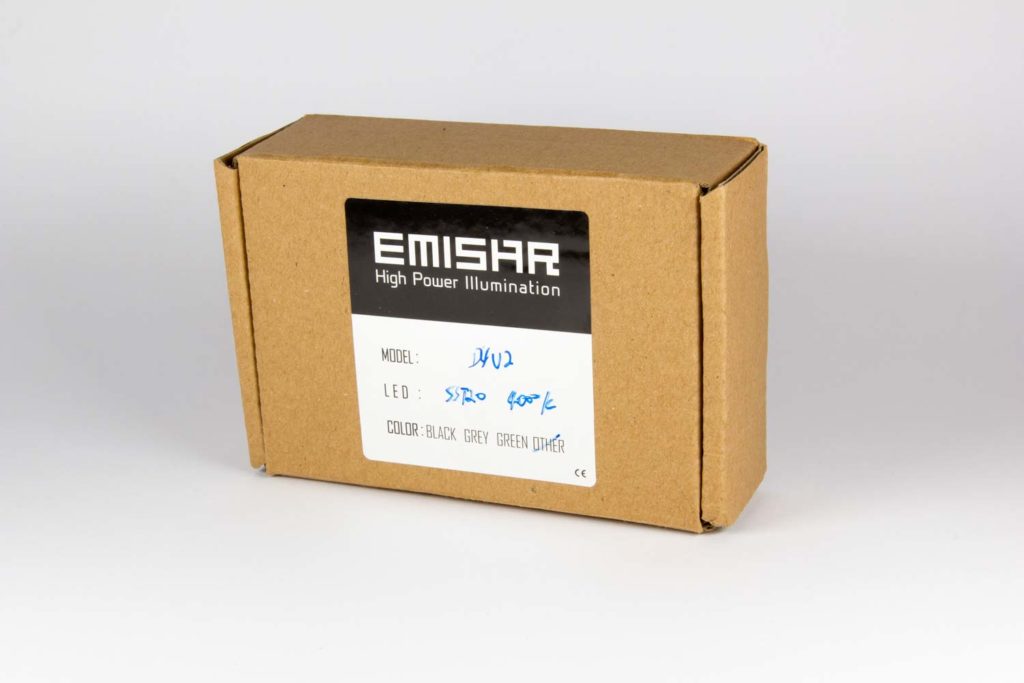
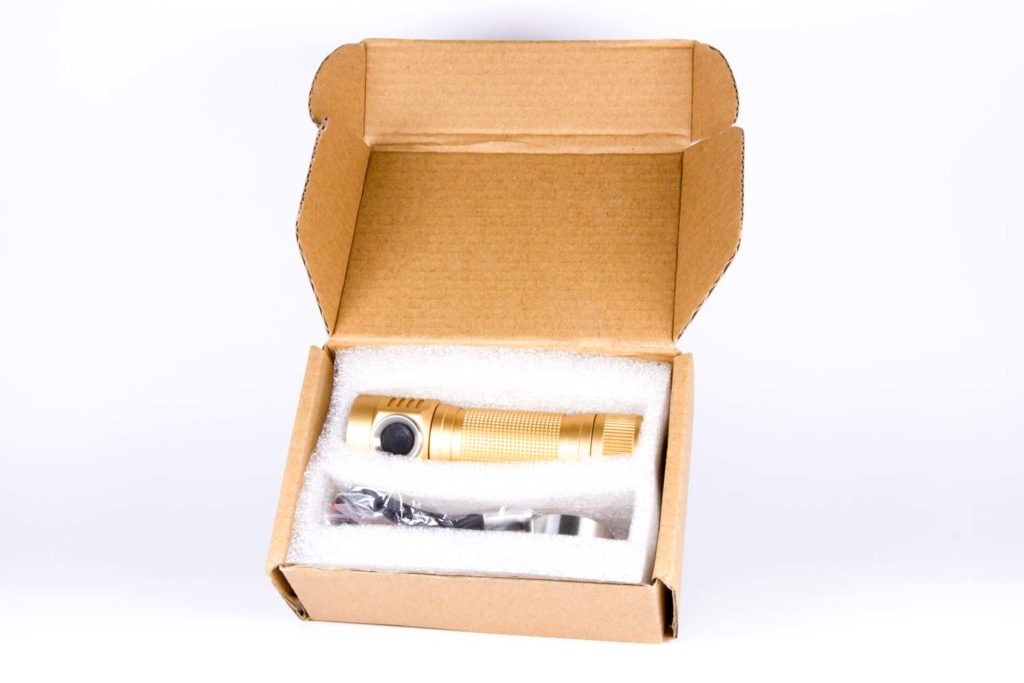
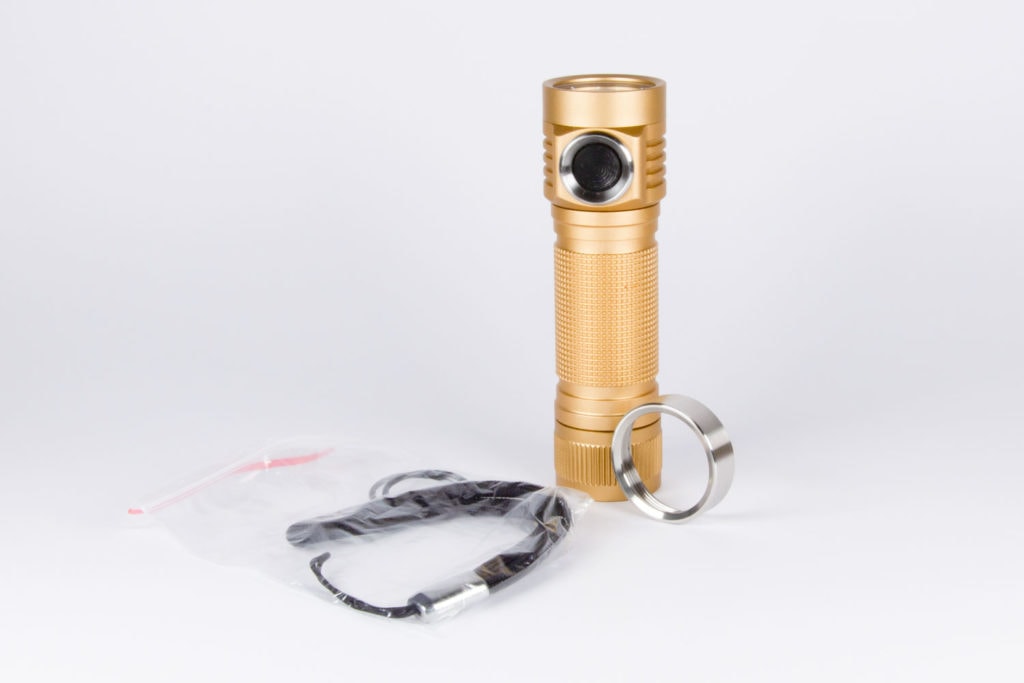
Emisar D4 v2 specifications
| Brand / Model | Emisar D4V2 |
|---|---|
| LED | Luminus SST-20 4000K 95CRI reviewed (also available in 3000K 95CRI, 5000K, and 6500K, Cree XPL-HI 4000K, 5000K, and 6500K, and Nichia 219C 5000K 83CRI). |
| Lumens | 3000-4300lm (3000 as reviewed, 2600 as measured w VTC5A) |
| Beam intensity | 18500cd |
| Battery config. | 1*18650 |
| Material | Material Aluminium w/ Stainless bezel |
| Modes | Lots! The D4V2 runs Andúril. |
| Blinkies | Candle, Lightning, Bike Strobe, Party Strobe, Tactical Strobe |
| Reflector | Carclo TIR. |
| Waterproof | No rating mentioned, and not going to try it! |
| Review date | February 2020 |
Handling of the light
The D4V2 is a fairly small light, so it nestles in my hand well. What I assume would be the usual configuration of holding it is with a thumb on the button, and it resting within, as per the images; it’s very easy to carry that way.
It’s nice and light while still feeling substantial, and will slip in a pocket easily. There’s an optional clip available; keep in mind though, removing it after it’s attached can damage the anodization due to the nature of pressure-fit.
The lanyard provided is quite a small one – I had some trouble fitting my hand through it. Once on, it’s secure for that same reason. I’d love to see some Armytek-style lanyards for once… positively huge.
Tailstanding: Go for it! The D4V2 has a wide flat base, and if you’ve opted for the magnetic base, you can attach it to any ferrous-metal surface you like. It has quite a good grab, too!
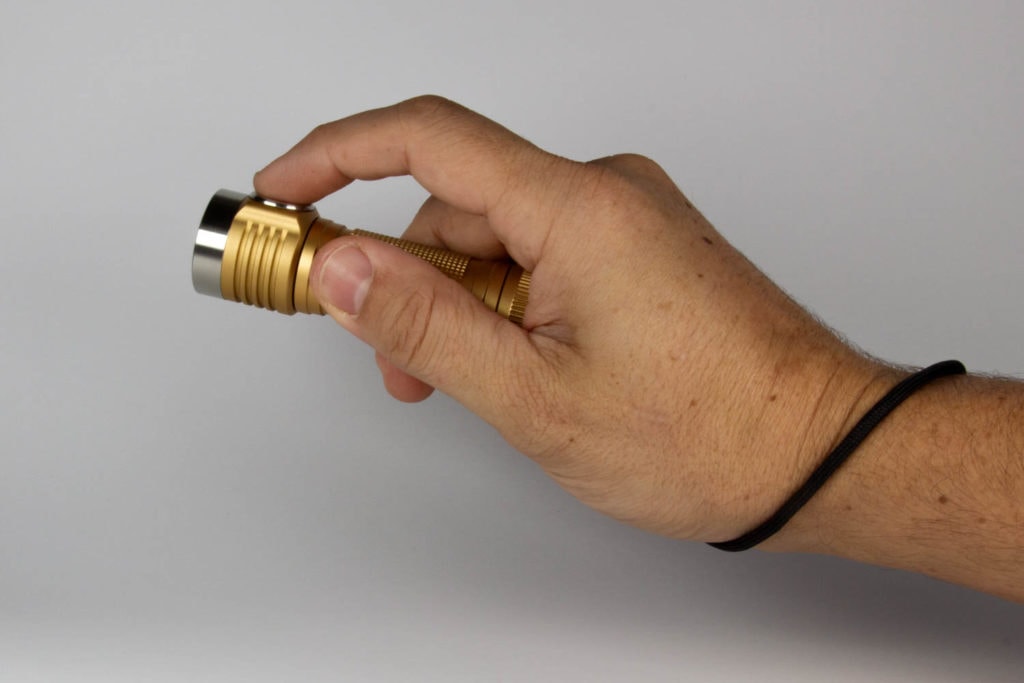
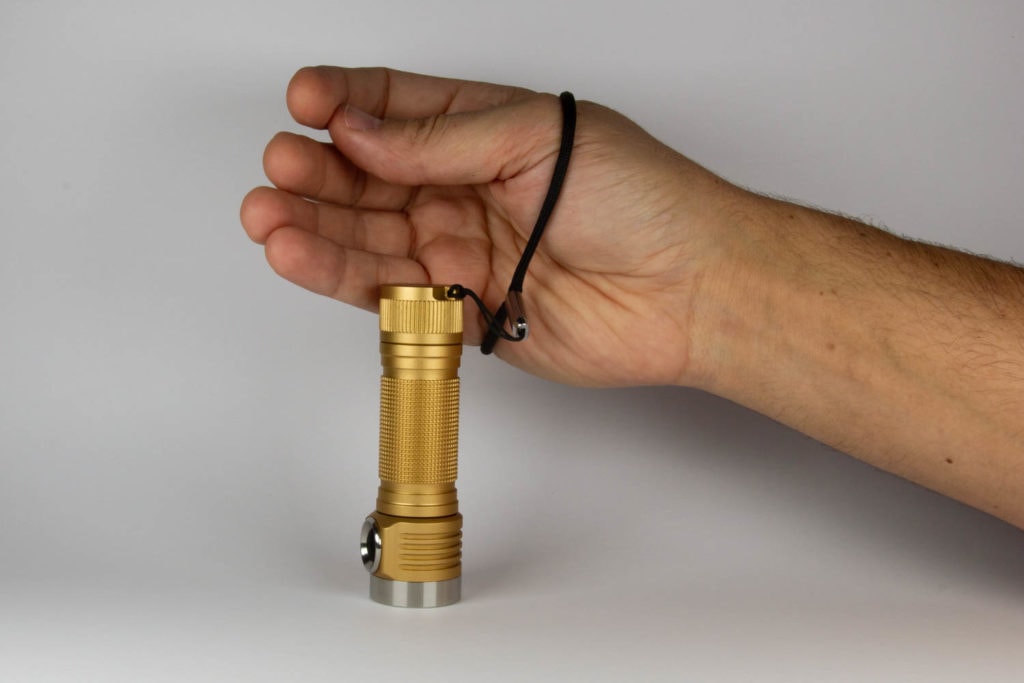
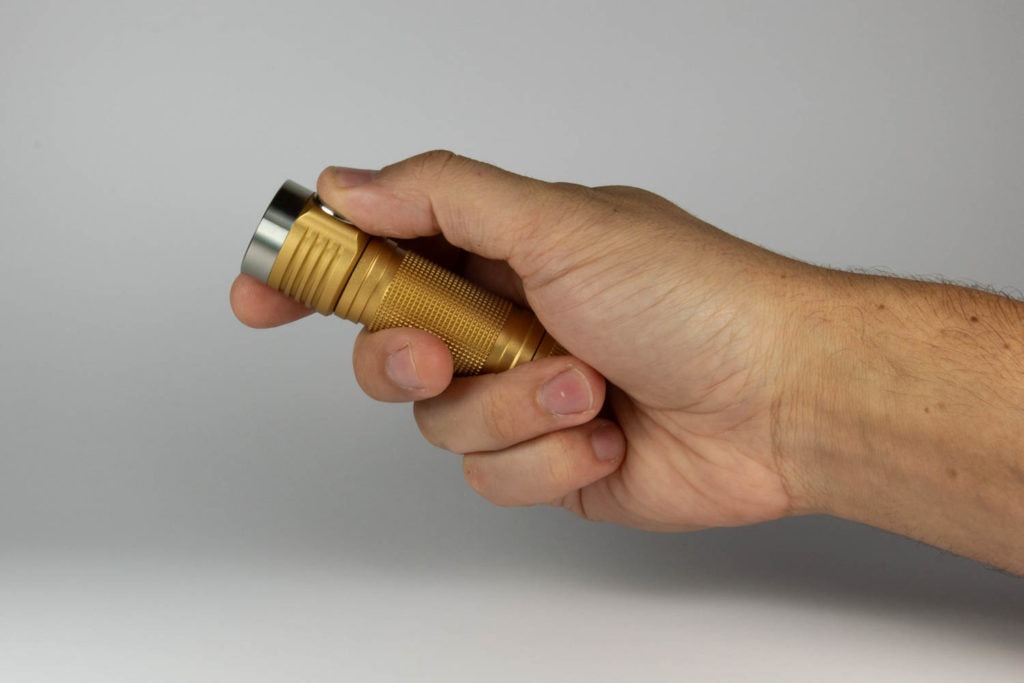
Build Quality, knurling, threads, and anodization
Based on everything I’ve seen of Emisar both from my own experiences and vicariously through the community, I’ve come to expect a high level of quality in their lights, and the D4V2 doesn’t disappoint. Everything about the light feels solid, from the detail on the knurling, through to the tolerances on the threads, and onto the soldering on the AUX board and MCPCB.
Anodisation on the light feels great. Not too smooth and not too chalky, it’s a nice lightly textured feel. I haven’t found any notching or missed spots in a look-over. The Sand colour that it on this light is very nice .It looks different to the photos I’d seen of it previously, and I’ve done my best to replicate the colour to my eye in my photos.
The stainless steel bezel feels slightly textured around the outside though – my assumption is that these are machining marks, which would be quite labour intensive to smooth down. It doesn’t detract from it in any way, but just an observation.
Lubrication on the threads is good, and this carries over to the o-rings. There’s no official rating on the water/dust resistance, but I would have no issues with it being splashed. I’m not sure I’d want to immerse it, but I’m moderately risk-averse.
Knurling is a “square” effect, and provides good grip to the fingers – the tailcap has longer vertical “lines” to provide great grip when opening and closing it.
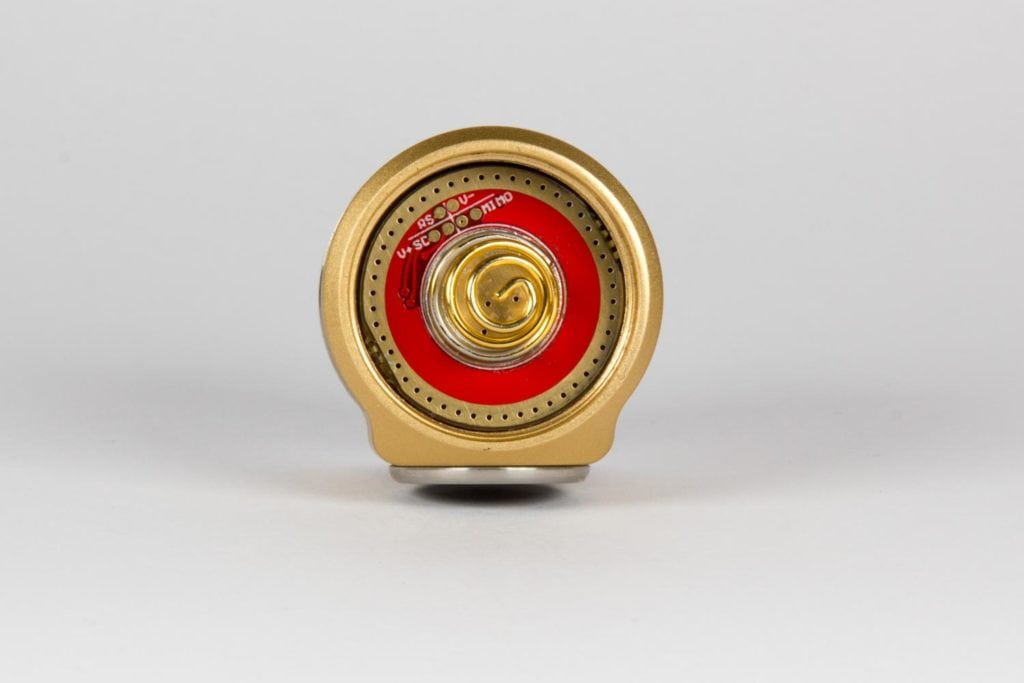
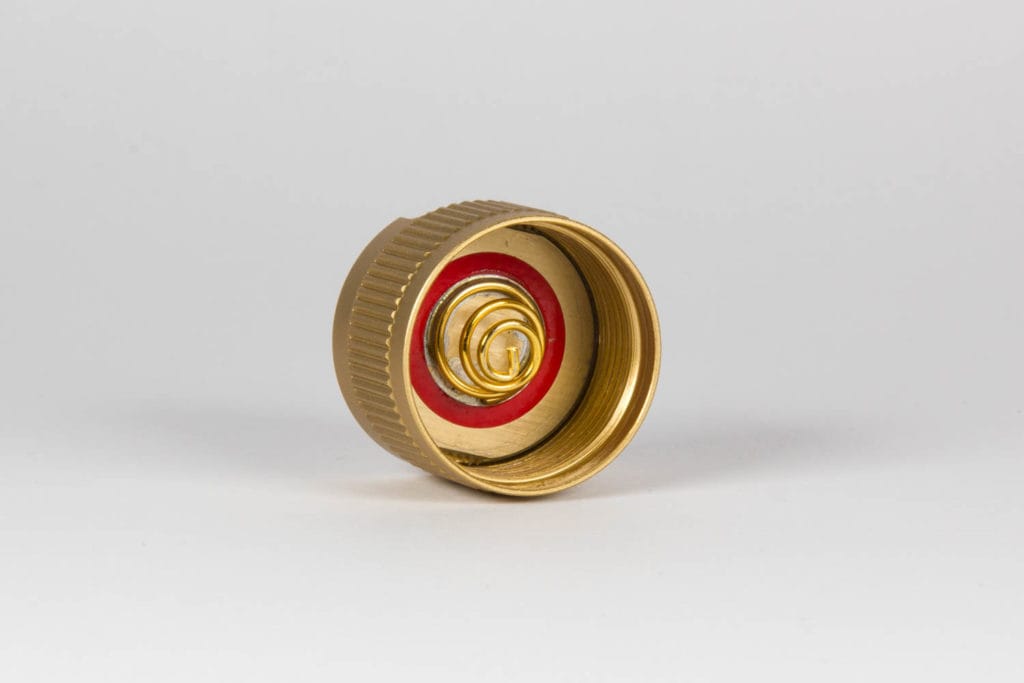
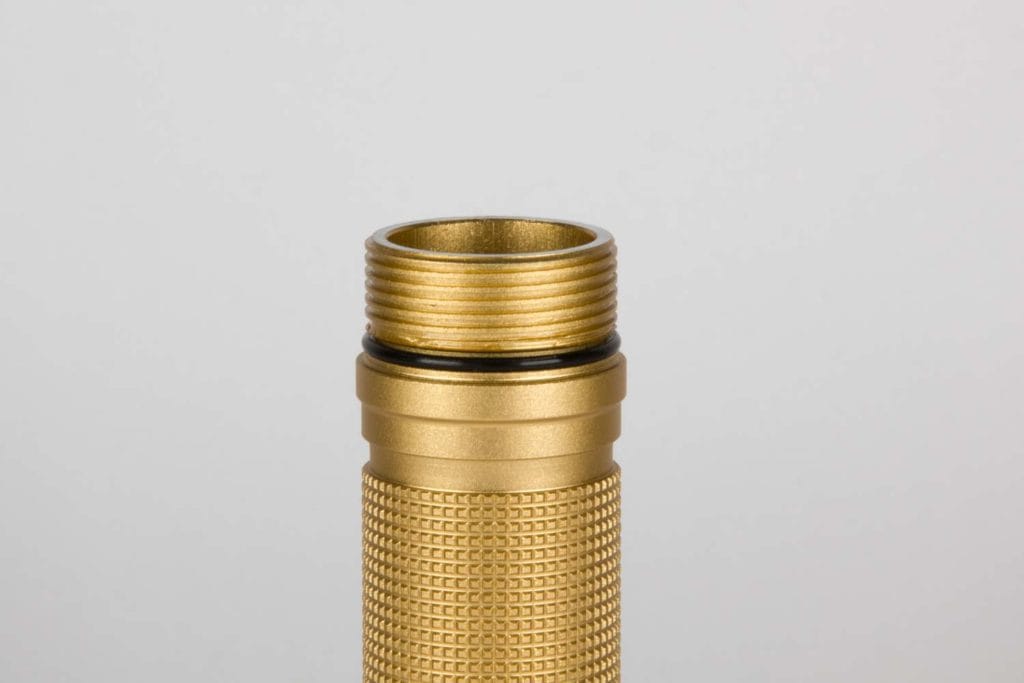
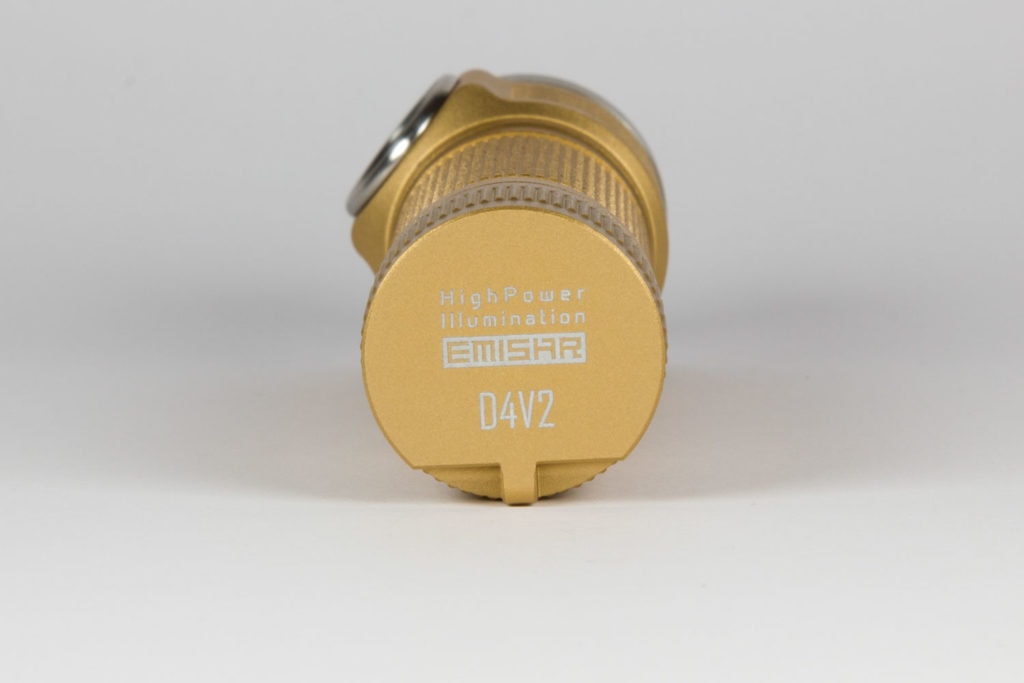
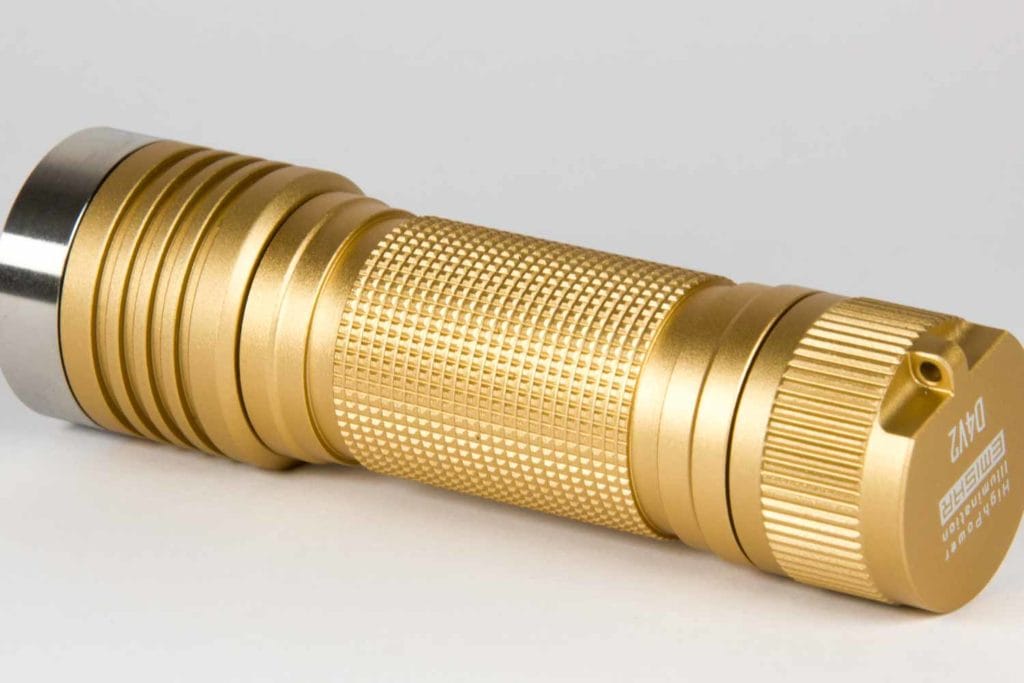
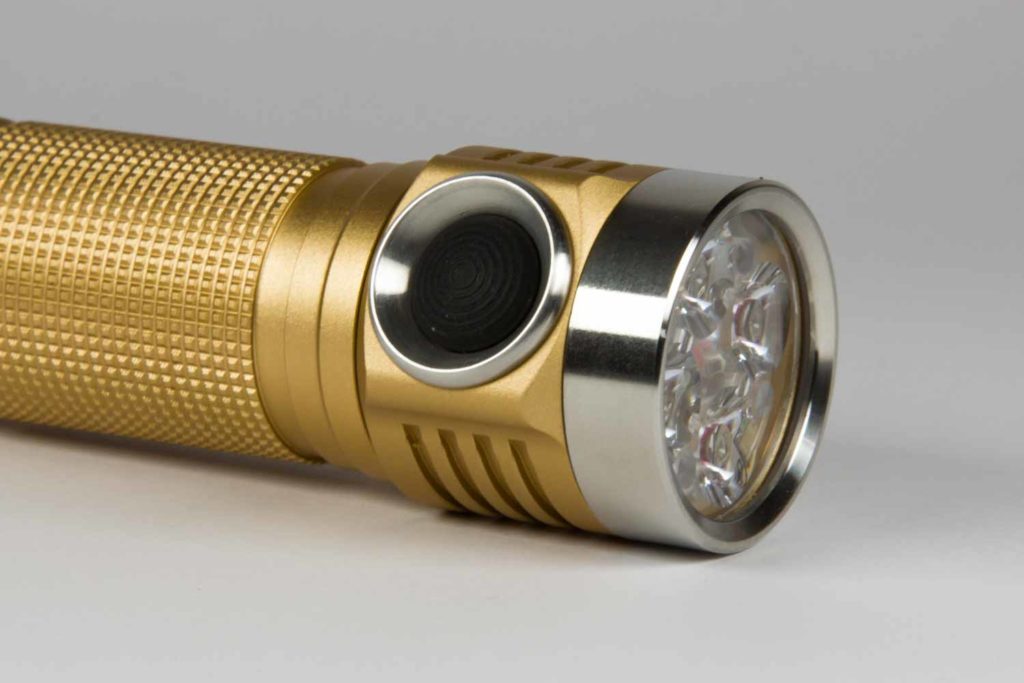
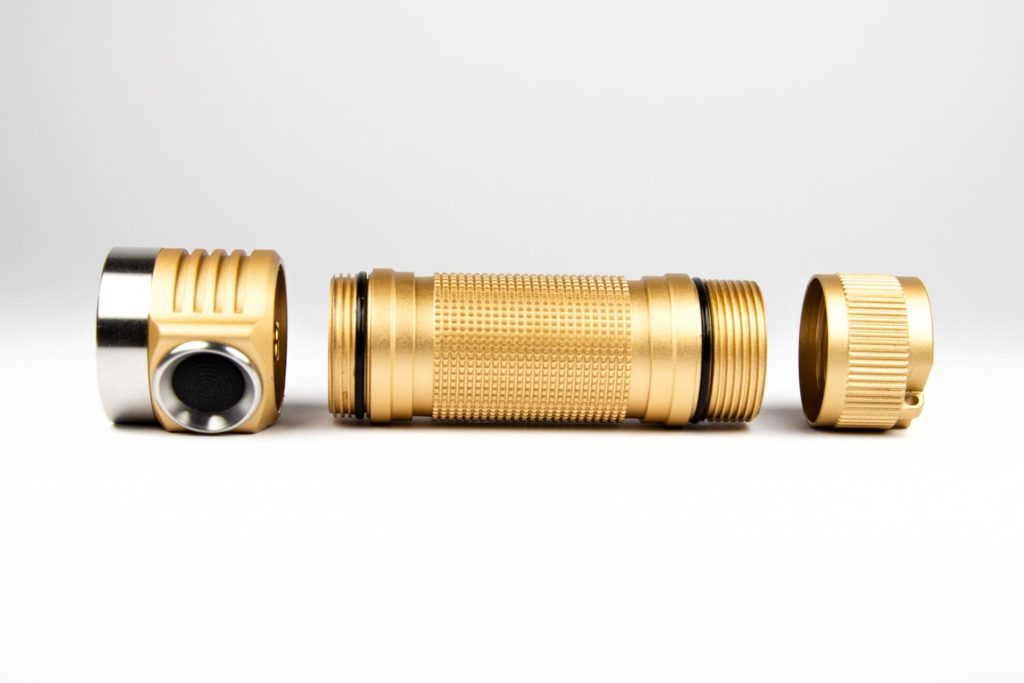
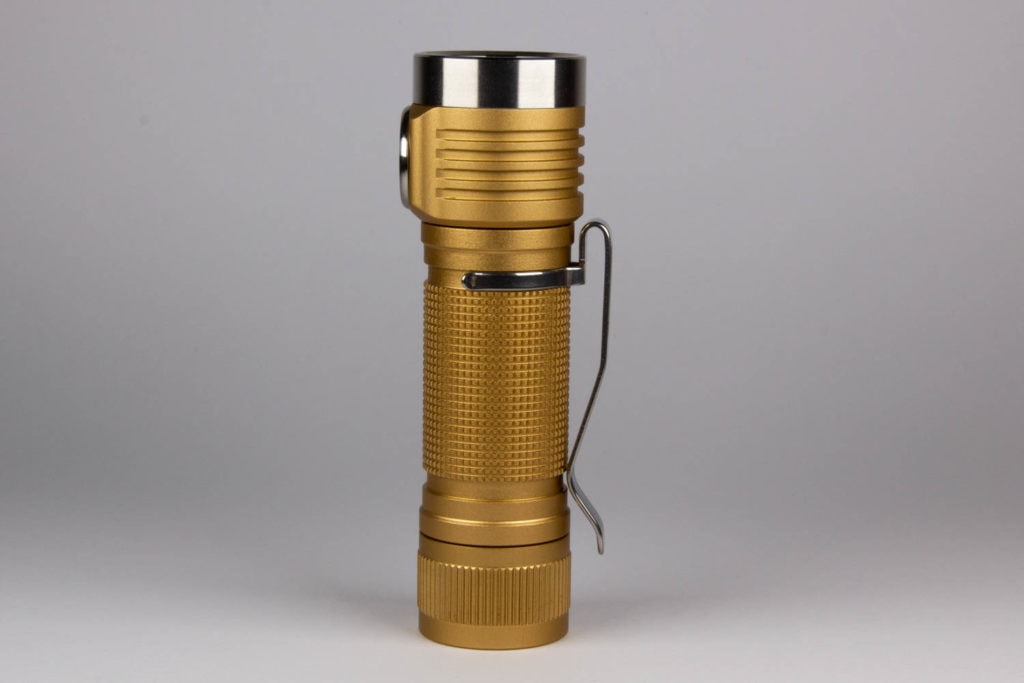
LEDs, Lens, Bezel, and Reflector
The emitter chosen on this light is the Luminus SST-20 4000K – while the XPL-HI might push out more light, I’m somewhat of a CRI-baby, so it was either the 3000 or 4000K SST-20. A 4000K Nichia 219C option would have been lovely, but we can only work with the options we have.
There’s an amount of green at lower power levels, which is to be expected – all SST-20s I’ve used bar the FA3 tint bin from the FW3A have an amount of green. This is one of the better tints, which is nice. Not far into the ramp, the tint disappears, and just looks nice.
The lens of the light is a Carclo 10622 optic under some AR glass, a clear TIR that gives more throw than the optional floody 1023. A note that I’ve seen a lot of mention of when it first came out – there’s a mark in the TIR that looks like a chip, but is actually part of the manufacturing process and has no impact on the beam or light output.
On top of all that is a lovely stainless steel bezel, which as I’ve mentioned above, has a slight “texture” to it; more of a very light grab on your fingers as you slide them over it.
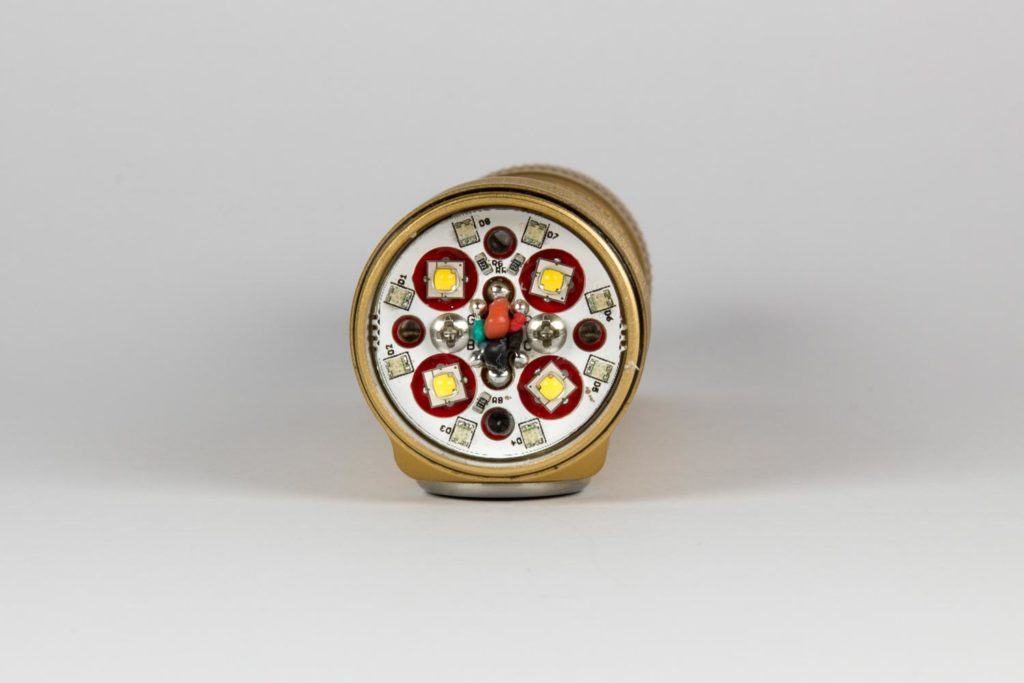
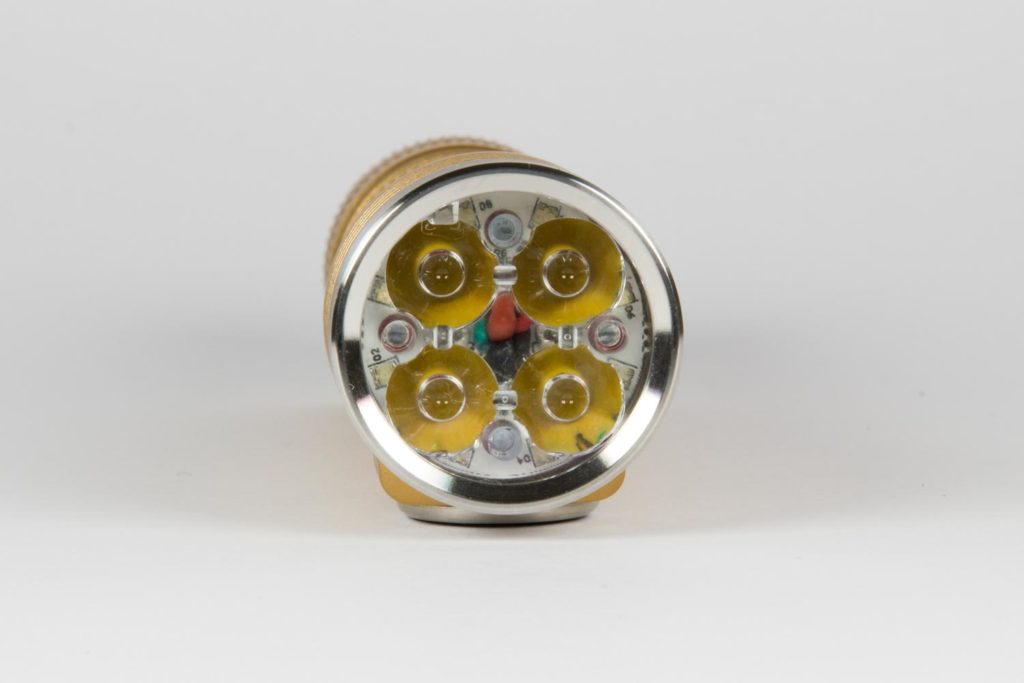
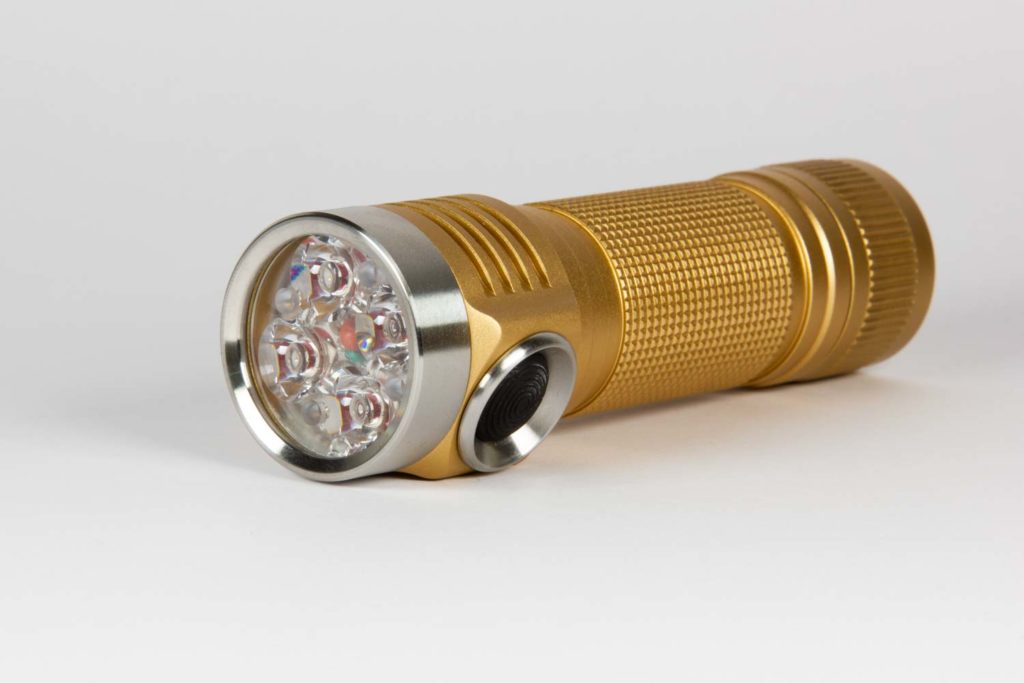
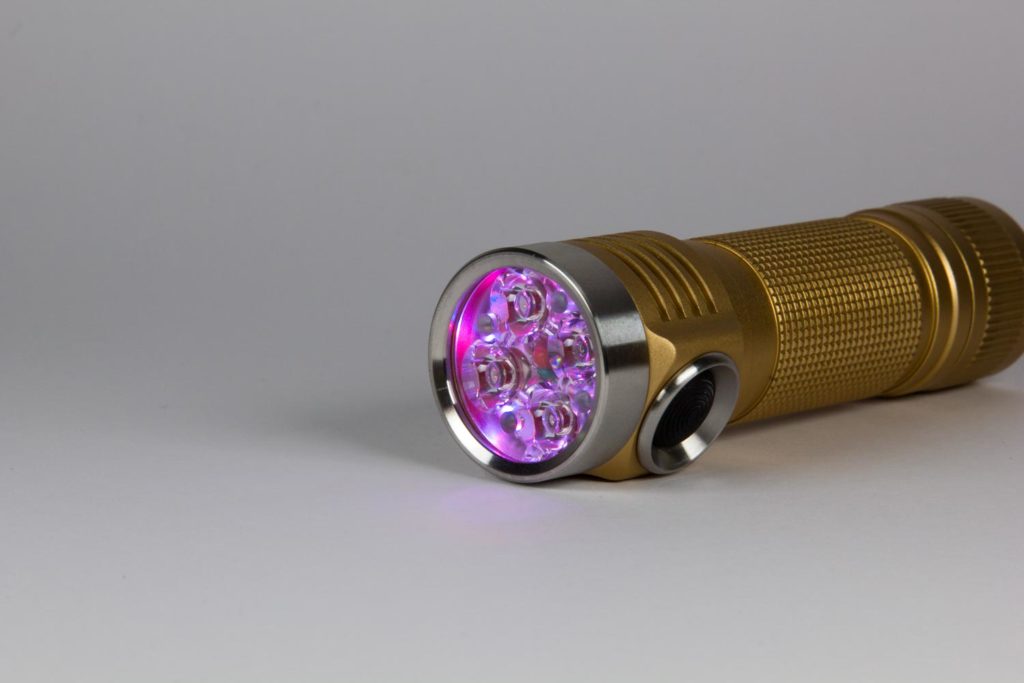
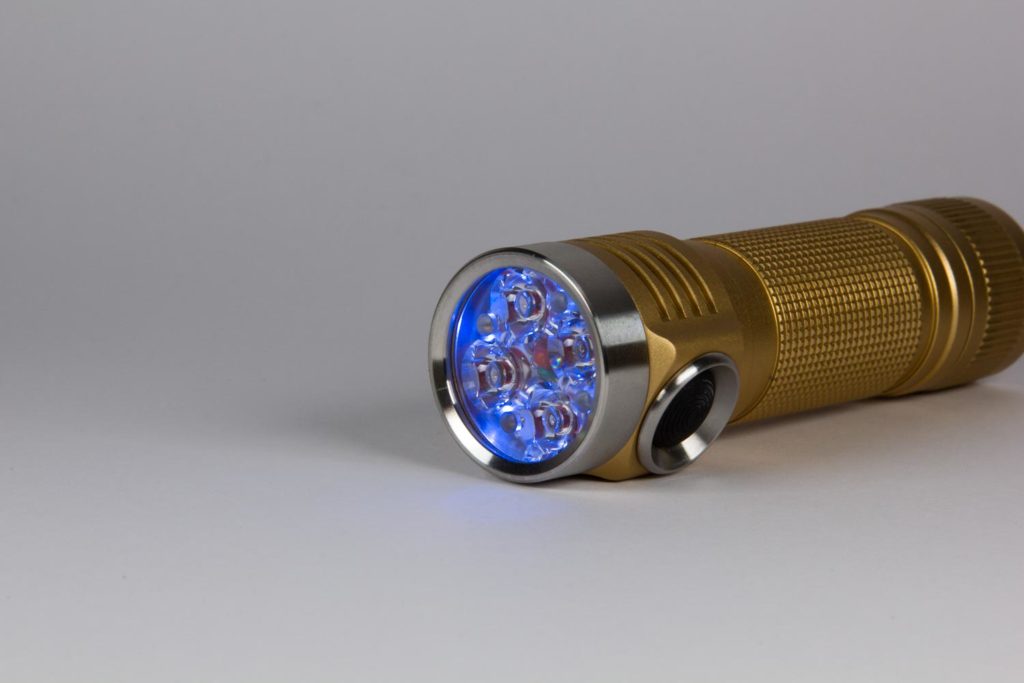
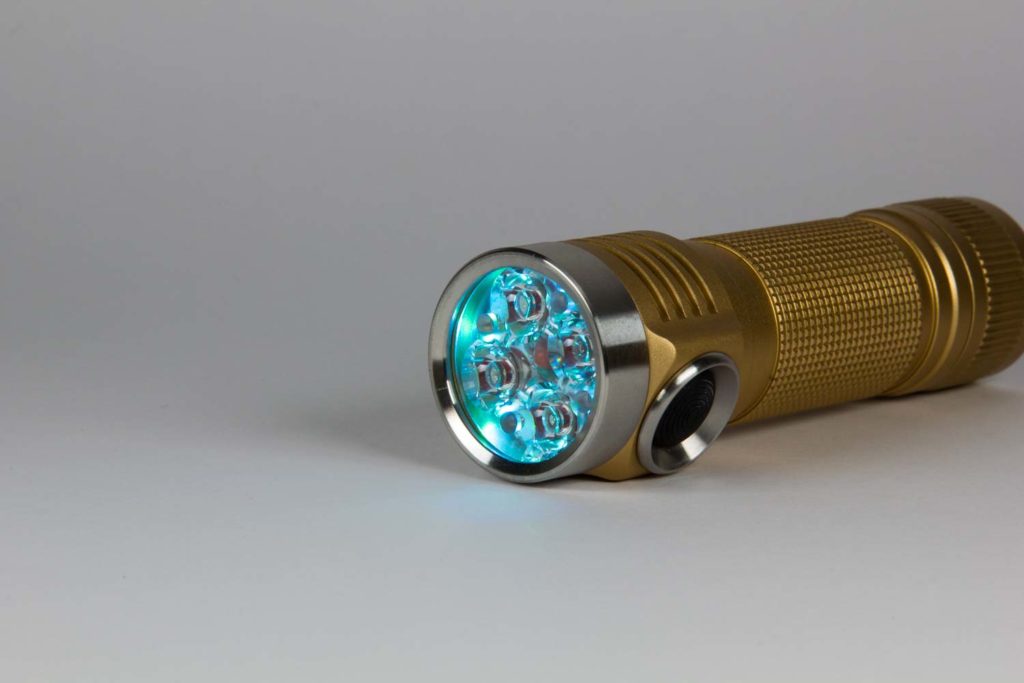
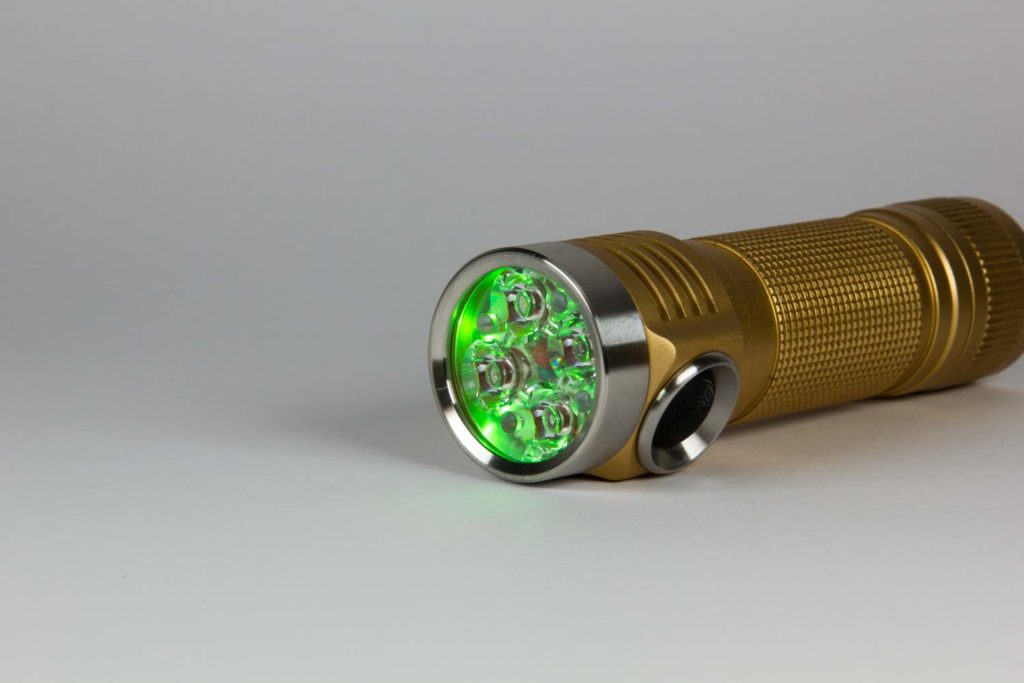
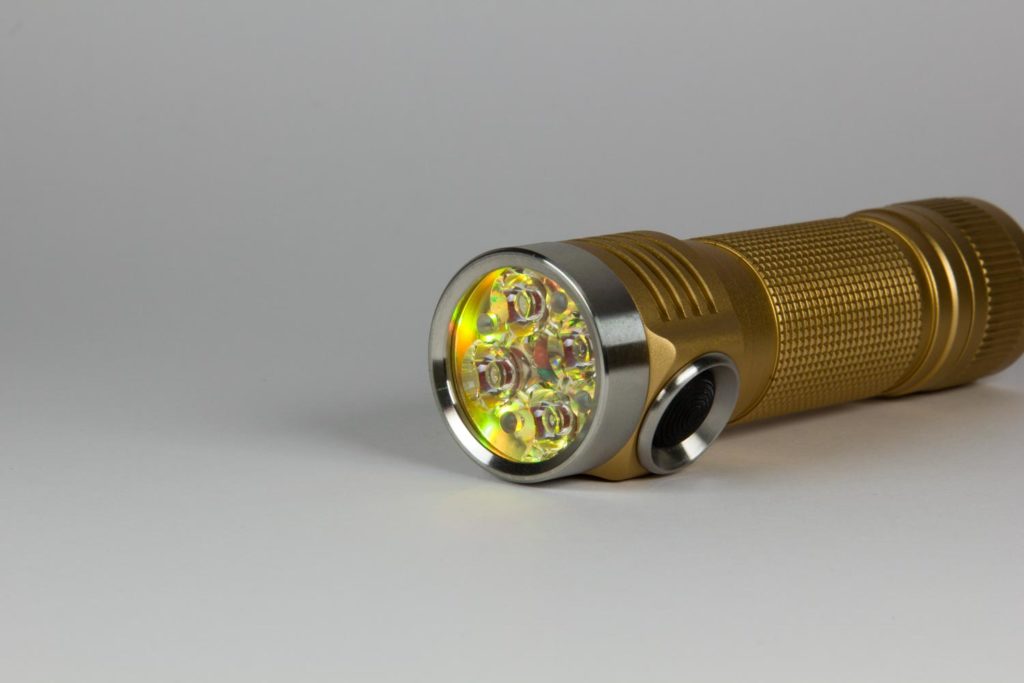
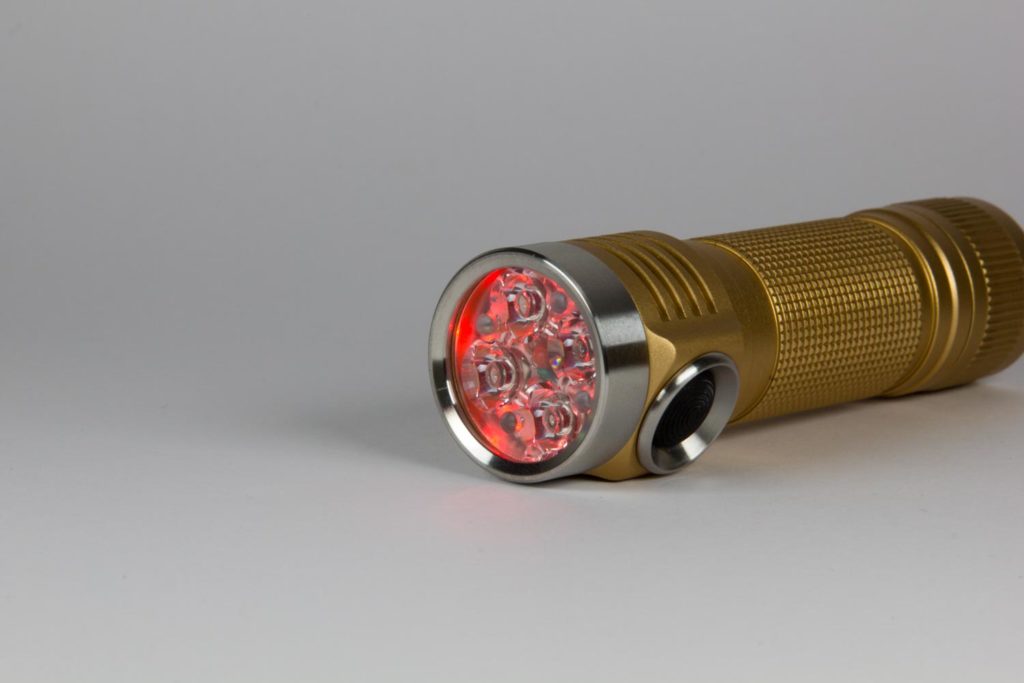
Dimensions:
- Length: 95.5mm (3.76″)
- Bezel diameter: 28mm (1.1″)
- Body diameter: 24mm on knurling (0.94″)
- Tail diameter: 25.4mm (1″)
Weight was taken with magnetic tailcap and stainless steel bezel.
- Empty: 75g (2.65oz)
- With Samsung 30Q: 121g (4.27oz)
Popular EDC flashlights
Compared to other great EDC flashlights.
Top 2 pictures: Compared to the Lumintop FW3A. The Emisar D4v2 is just a tiny bit longer.
Bottom left: Size compared to the first Emisar D4.
Bottom right: From left to right: Convoy S2+, Emisar D4v2 and Astrolux MF01 mini.
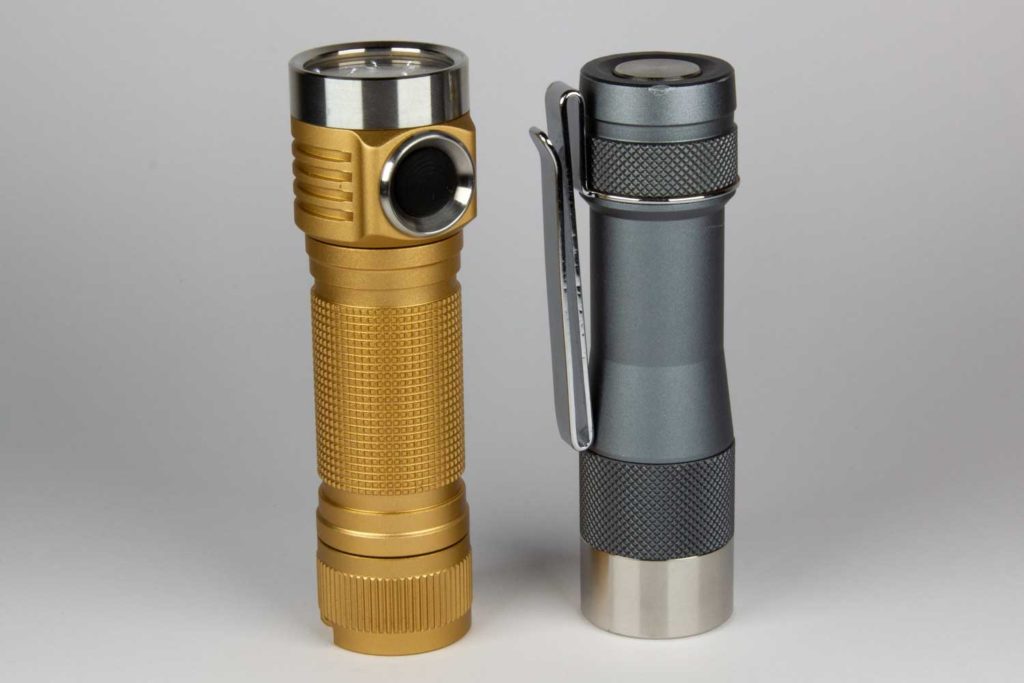
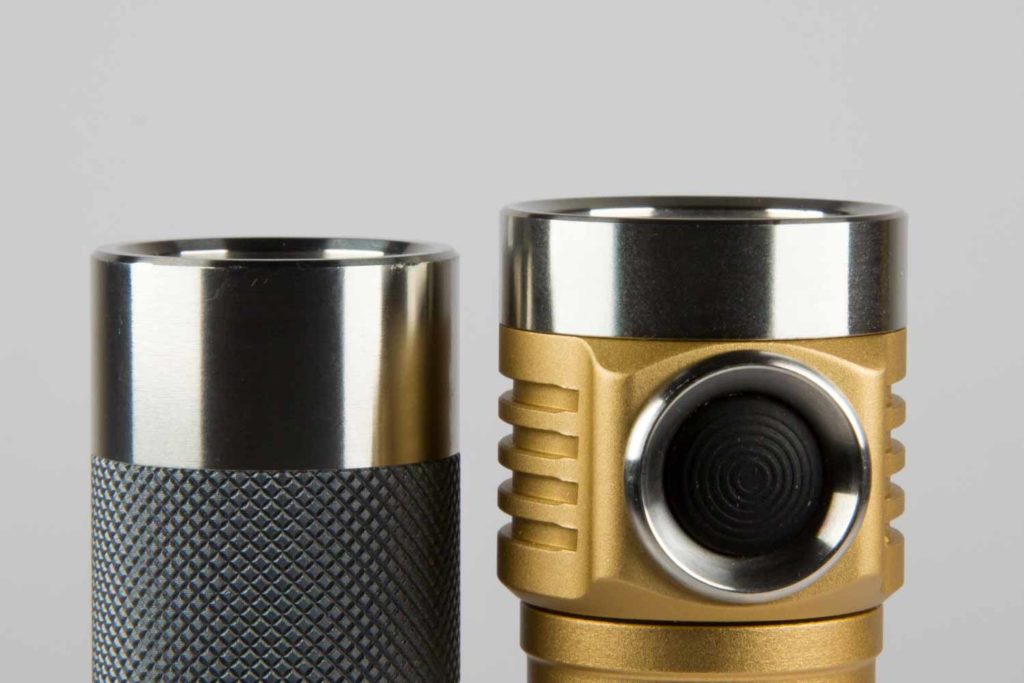
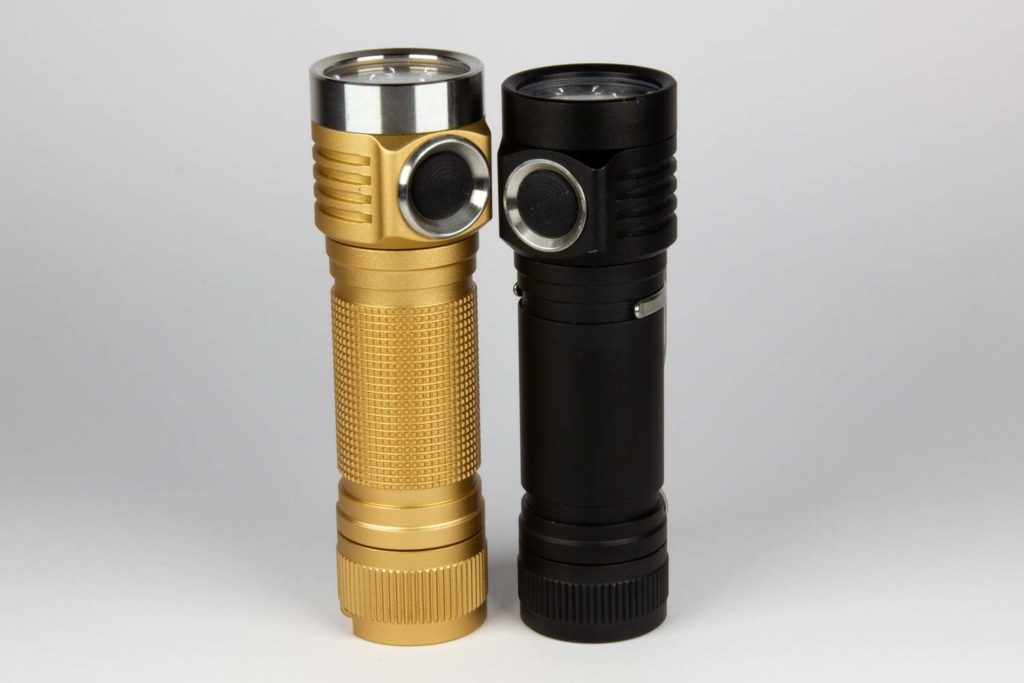
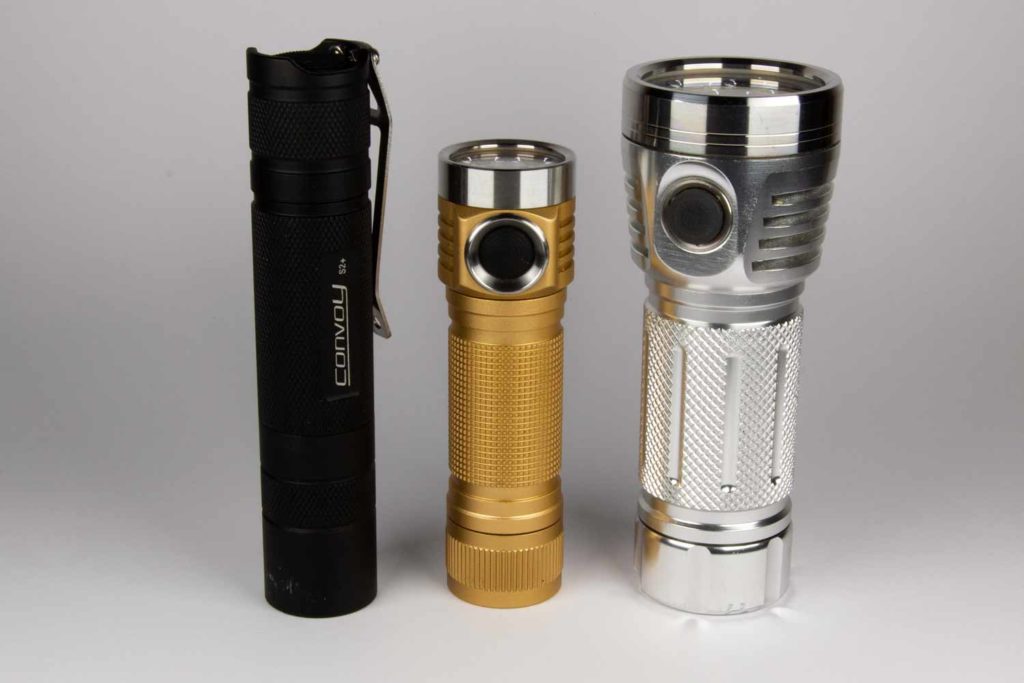
Emisar D4 v2 Driver & User Interface:
The D4V2 uses a custom FET+1 driver running Anduril, which is hands-down my favourite UI. There’s pads on the accessible side of the driver to enable flashing of the firmware to later versions, but this requires a specific pogo pin adapter that is also available from intl-outdoor .
An awful lot! Anduril is one of the more intuitive UIs I’ve used, while also being extremely customisable. The general gist of it is:
Modes:
An awful lot! Anduril is one of the more intuitive UIs I’ve used, while also being extremely customisable. The general gist of it is:
From OFF:
- Click – On (to mode memory).
- Hold click: On to bottom of ramp
- Double Click: On to top of ramp
From ON:
- Click – Off.
- Hold click: ramp (or step) upwards, quickly release and hold again to ramp (or step) downwards
- Double Click: Turbo
From there, it can get ridiculously complicated – a UI diagram is here:
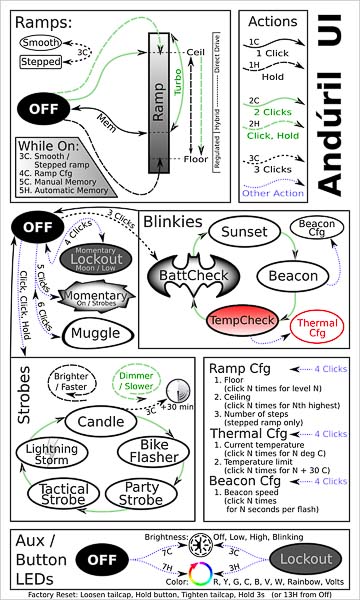
The driver board is an FET+1, which uses regulated modes below 350mA. The 7135 (the +1) helps keep output steady up to 350mA, but has a hard limit on brightness – going above that lets the FET take over and pull as much as it can out of the battery.
LVP
The light has low voltage protection, and lockout is done by either untwisting the tailcap ¼ turn for a mechanical lockout, or clicking four times for software lockout. While software locked, holding the button will do the bottom of the ramp, and clicking twice and holding the second will do the bottom of the stepped mode, which by default is slightly brighter.
PWM
There’s PWM in all modes from what I can see with my phone camera, but not visible to my eye. As a result, I consider it a non-issue.
D4v2 Batteries and charging:
This light takes non-protected 18650s only – the entire point of this light is to be a hotrod, so protected batteries would be missing the point entirely. The higher amperage cell you can throw at this the better; 30Q or VTC6 is a good balance of power and longevity, but if you want it all at the expense of duration (and possibly the first few layers of skin on your hand), then go the VTC5A.
There’s no charging onboard, which keeps the size down.
Emisar D4v2 Test: Performance
This review is going to be a little different – it seems I’ve had some… questionable quality 30Qs, and so I’ve bought some new guaranteed genuine cells, as well as some VTC6 and VTC5A cells. I’ll be using each of those for measurements, fully charged each time.
Unless otherwise specified, all readings are from a fully charged Samsung 30Q. I tested current with a Fluke 87 and short 12AWG wires, to eliminate losses over wire.
For larger amperages, I’m using a Uni-T UT210E clamp meter with a custom-made wire loop using 8AWG.
Amp measurement (at tailcap) Given that there’s AUX LEDs here, I’m going to do a full test run on all the modes and colours. There’s Off, Low, High, and Blink – I’ll only test low and high, as Blink is a sort of “heartbeat” flash.
Standby current:
| Aux | Low | High |
| Red | 90μA | 6.86mA |
| Yellow | 150μA | 8.13mA |
| Green | 80μA | 1.44mA |
| Cyan | 120μA | 2.92mA |
| Blue | 70μA | 1.57mA |
| Violet/Magenta | 140μA | 8.25mA |
| White | 190μA | 9.5mA |
| Off | 25μA | 25μA |
Rainbow mode will cycle through those colours with the exception of white (changes every two seconds), so I’ll omit it.
Ramping:
Harder than expected. Due to the nature of ramping, picking spots in it is almost impossible, but I’ve done a measurement just after the “middle” flash while ramping up, so while not overly scientific in approach, it’s about the closest I’ll get.
- Bottom of ramp (moonlight): 2mA
- Mid-way “flash”: 400mA (most likely at the full 7135 output; top of regulated mode)
- Top of ramp: 6A
- Turbo: For this one, I’ll use the three batteries:
- 30Q – 17A
- VTC6 – 17.2A
- VTC5A – 17.2A
I seem to be hitting a hard limit there, which I think is a limit of my testing setup. I’m going to order some parts, redo wiring and soldering, and update these results at a later date.
Stepped:
As mentioned above, step 4 is the top of the 7135 (or close to it), I measured 326mA, or ~7% less than the 7135 can output at maximum. Not a particular issue, just something of note.
- Step 1: 10mA
- Step 2: 40mA
- Step 3: 132mA
- Step 4: 326mA
- Step 5: 1.03A
- Step 6: 2.92A
- Step 7: 6.06A
Emisar D4v2 Battery life: runtime graph
I’ve done two graphs – one on ramping mode and kicking to turbo, and one on stepped mode, step 6/7. Turbo mode, as expected, quickly ramps down. From a huge 432% of 30s, then running for just over three hours. Keep in mind, after 5 seconds of so, the light is hot to the hand; in colder climates this might not be a problem with gloves on, but in Australia we’ve been having nights at 26-29 degrees C (79-84 F)… not very conducive to keeping it cool!
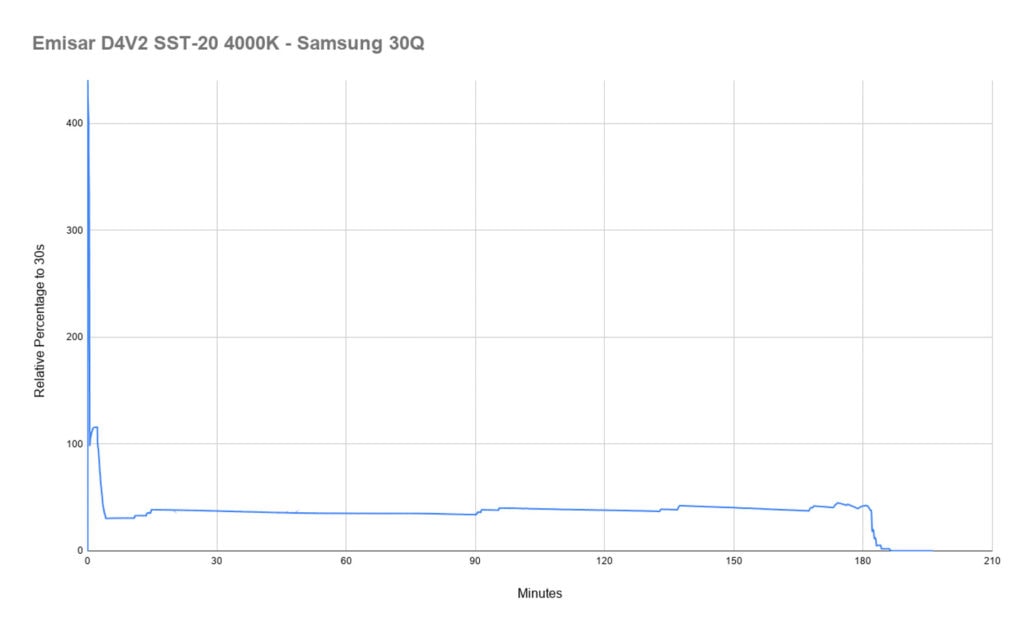
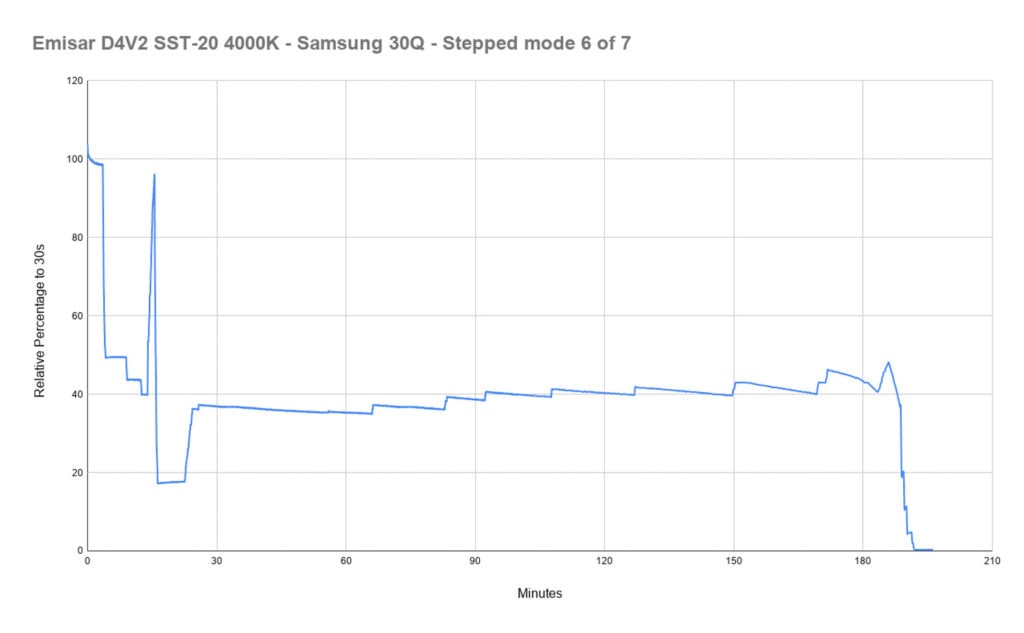
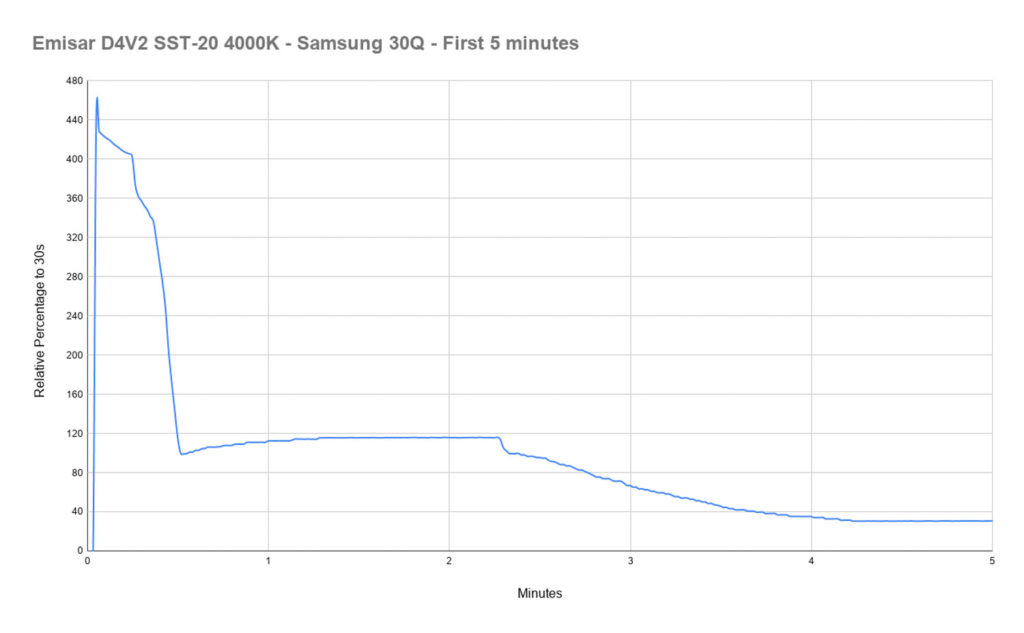
At the end of this run, it trailed off to almost nothing, and I didn’t notice for quite some time. After turning the light off, I measured the battery at 2.92V.
The second graph is running the light on step 6 of 7 on stepped mode – some definite oddities with bouncing around. I’ve spoken to ToyKeeper about this, and she’s mentioned a few things – one, this firmware is the original version she handed to Hank for the light (2019-10-15), and later versions have helped smooth this out. Two, she’s also re-writing the code for better thermal response and regulation, so it’ll be even better in the future.
I have the flashing kit on order, and when it arrives, I’ll reflash the light, and run the runtime on stepped mode again. Lumen measurements (for each mode) With my lumen tube now built and calibrated with lights from Maukka (BLF), my readings are as such:
Ramping:
- Bottom of ramp (moonlight): Too low to read
- Mid-way “flash”: 132 lm
- Top of ramp: 1203 lm
- Turbo: 2357 lm
Although – for giggles, I tested with a VTC5A, and got 2604 lm on Turbo.
Stepped:
- Step 1: Too low to read
- Step 2: 9 lm
- Step 3: 38 lm
- Step 4: 96 lm
- Step 5: 298 lm
- Step 6: 682 lm
- Step 7: 1212 lm
Step 4 is using the 7135 at 100%, so the top of fully regulated mode. From then, it’s 7135 + FET.
Throw numbers:
Measurements were taken both indoors and outdoors with the Uni-T UT383S. I took three measurements at both 5m for indoors and 10m for outdoors, and so as to account for any variance in my aim, I’ve averaged the results. Given that this light is a multi-emitter light, I’ve set the lux meter to “max” mode, and waved the light gently around to let all of the hotspot hit the sensor, so as to capture the brightest point. Using turbo mode, I get:
Indoors (5m)
- 30Q – 18,300cd = 270.5m throw
- VTC6 – 18,450cd = 271.6m throw
- VTC5A – 19,800cd = 281.4m throw
Outdoors (10m)
- 30Q – 18,500cd = 272m throw
- VTC6 – 18,650cd = 273.1m throw
- VTC5A – 20,000cd = 282.8m throw
This was actually one of my better readings – all readings were almost the exact percentage different to their inside reading, which is around 0.5% difference. Very happy with these results. As expected, the VTC5A has the highest candela, but also turns into a flaming ball of pain for your hand very quickly unless you’re somewhere cold, which I’m most definitely not.
Beamshots
2021-07 update: the following beamshots were taken by Dave.
Photos were taken with a Pixel 3a, set to 1/2s shutter speed and ISO 400, F1.8. White balance was locked on cool white.
Distance to the bench is 6m, tree on the right is 13m, tree on the centre right is 18m and the building behind it is 69m.
- Emisar D4V2 (4000K)
- Jetbeam EC26
- Lumintop D1 (3000K)
- Lumintop FW4X (4500K)
- Lumintop Gift-G1 (4000K)
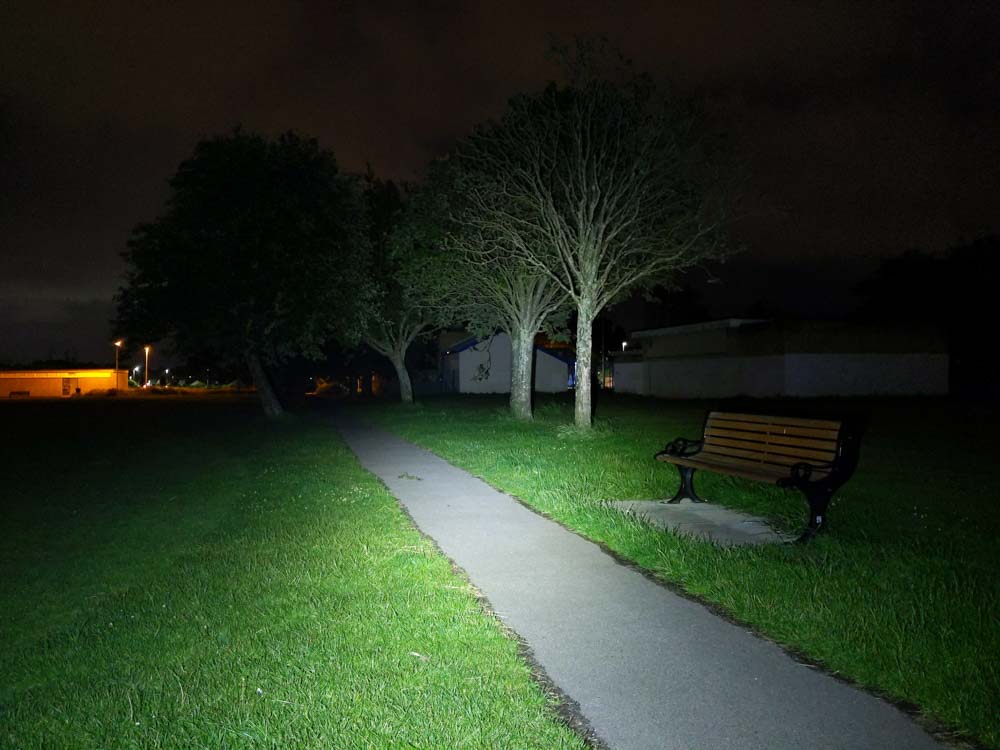

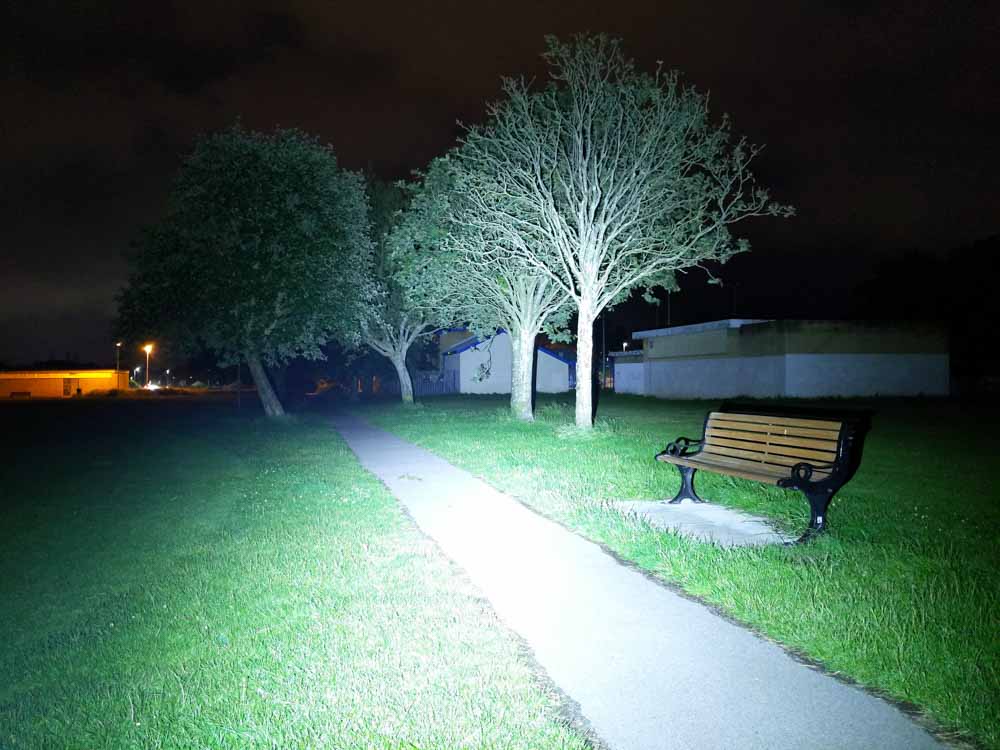
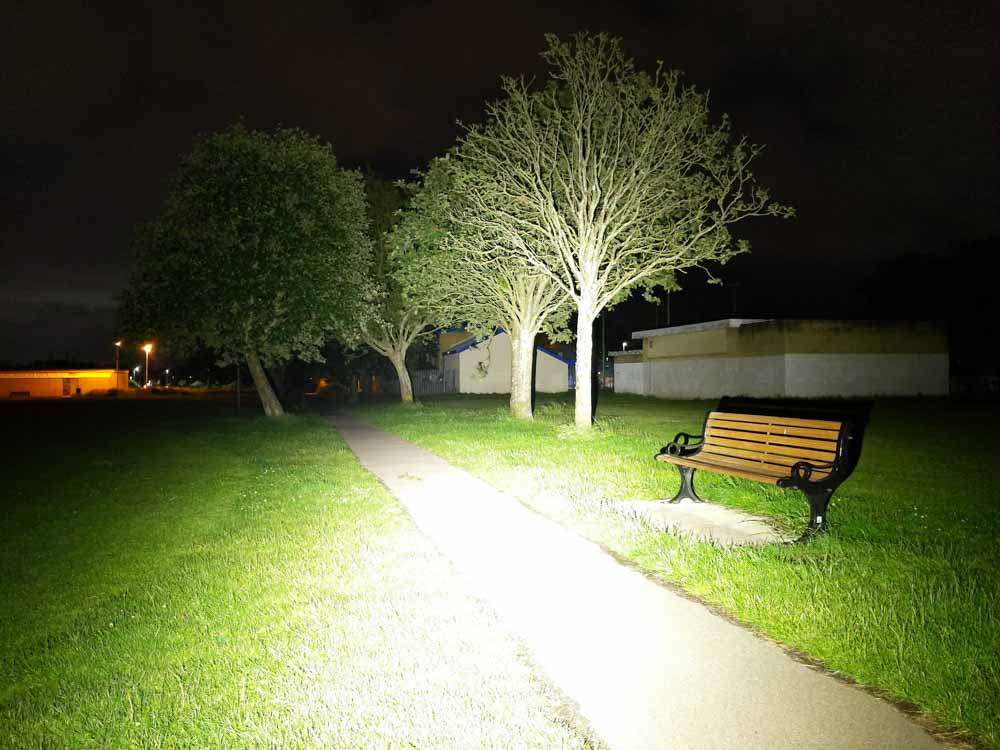

Disclaimer: This flashlight was bought with our own money. We have not been paid to review, nor have we been holding back on problems or defects.
Final verdict
Pros:
- Whoooole lot of light in a small package
- Andúril firmware
- Aux LEDs are fantastic
- Magnet is quite strong
Cons
- Due to size, heats up and ramps down very quickly
- Slightly less-than-perfect machining on Stainless Steel bezel

Rating: 5 stars: ★★★★★
Where to start the conclusion? This light is the quintessential hotrod – small form-factor that pushes out a ton of light, heat efficiencies (and your fingerprints) be damned. That said, there’s also plenty of use in it in the lower modes too; it’s very versatile in that lower modes regulate quite well. The auxiliary LEDs are great and fun to play with, I love the stainless steel bezel despite putting it as a con above as it really doesn’t detract from the light much if any, and it’s just great fun seeing the look on people’s faces when I kick it into turbo. I’m very happy to award this light 5 stars, and can’t wait to see more from Hank/Emisar in the future.
Emisar D4v2 for sale
1lumen selects and reviews products personally. We may earn affiliate commissions through our links, which help support our testing.